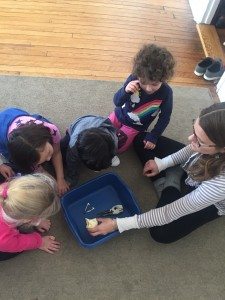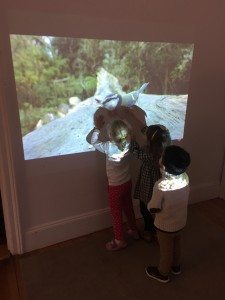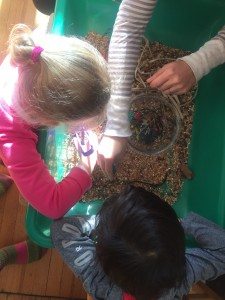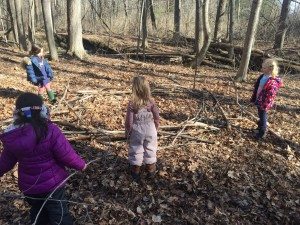It all started with a crow. PreK was taking a hike through the woods, and a crow swooped down and landed on a tree nearby and started cawing. The next day we were on the playground, and we saw a beautiful red-tailed hawk soaring. Then suddenly a group of crows started working together to chase it away. The children’s interests grew as they started noticing all the different birds that frequent the feeders in front of the science building. They asked questions about what birds eat and how they sleep. A study was born.
The Reggio Emilia approach believes that children are capable of constructing their own learning. And that they are driven by their interests to understand and have a deeper knowledge of the world around them. After we realized that the children were showing an interest in birds, we had a meeting to discuss what we already know about birds and what we want to learn about them. They came up with a great list of questions: Do birds have teeth? Why do they fly? Why do they tweet? Why do some birds fly away when it snows? As the children shared their own prior knowledge of birds, they taught their classmates, who in turn added their own ideas and observations.
PreK’s interests grew as we learned to “speak” chickadee. We played games only using a chickadee’s language, telling friends that we found food, all is good, or sent a loud warning that a Cooper’s Hawk is lurking.
We built nests out of clay, twigs, moss, and dried grasses. They also created a “rainbow nest” with a cardboard box.
We studied and felt bird skulls.
We saw different birds hunt, make nests, and eat through videos that we watched in the classroom.
We learned about different beaks and why they were different shapes.
Most recently we have begun to build a 8-foot nest out of branches and bark in the woods. The children ask to go to our nest daily. They want to add to it, play in it, and “lay” eggs in it. It is their “home.”
Like other Reggio investigations, it has been fascinating (and fun!) to see where the kids have taken this study—and in particular, to see how invested they have become in birds! They have learned patience and how to quietly observe birds; they have learned that there are many varieties of birds and how each kind is brilliantly adapted to its environment; they have built their cooperation skills as they construct community “nests” for the class, both indoors and out; and they have developed their diligence and perseverance in pursuit of answers to their questions.
Vicky





